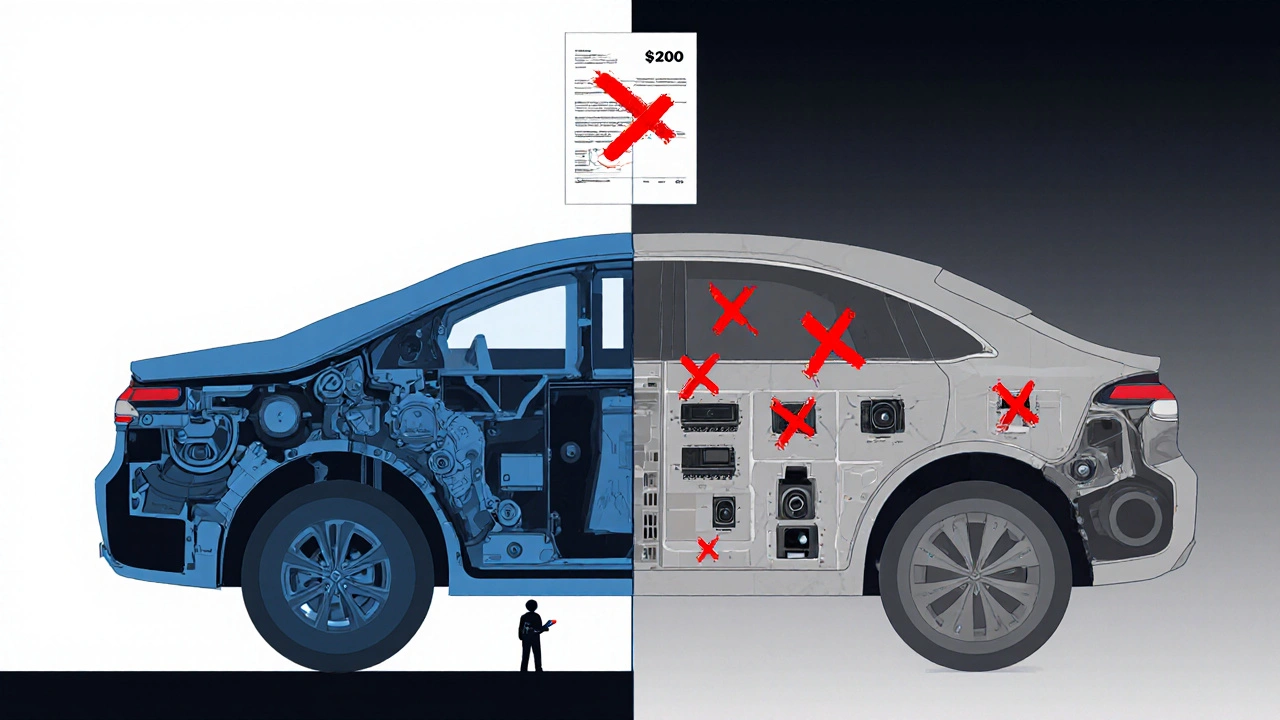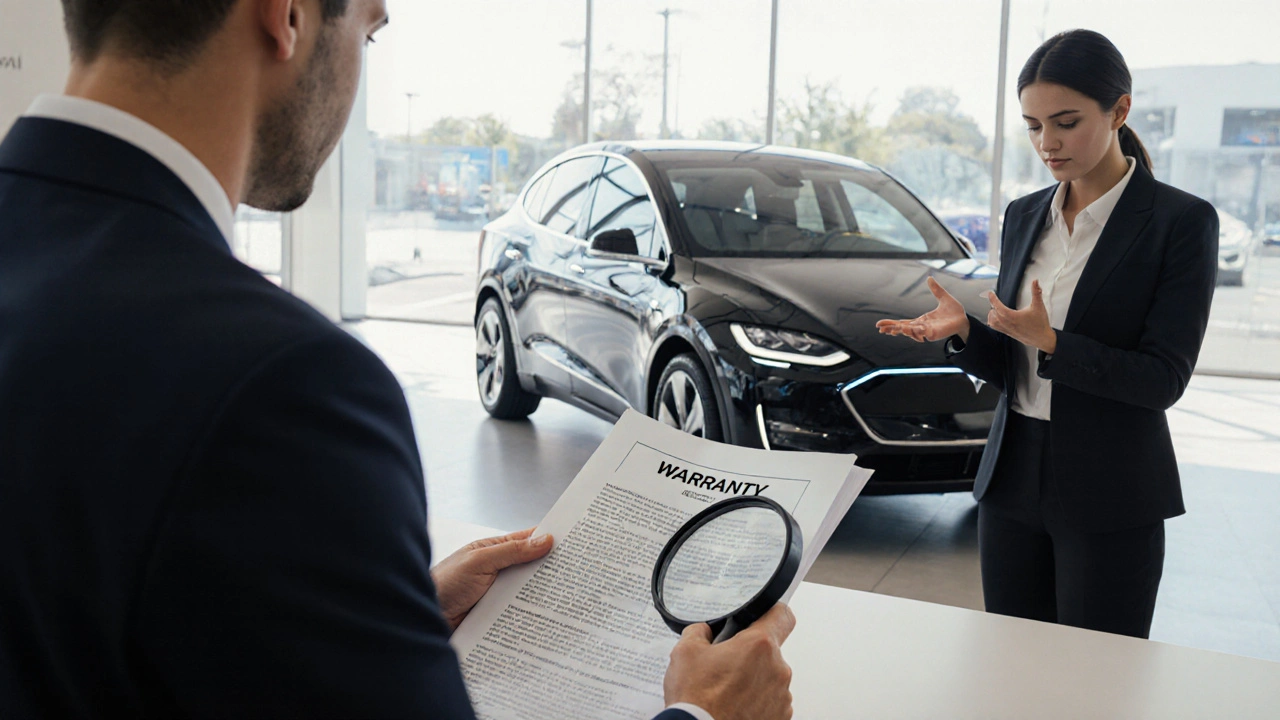Car warranties used to be simple: buy a new car, get three years or 36,000 miles of coverage, and you’re covered for engine and transmission failures. That’s not the reality anymore. In 2025, warranties are more complex, more expensive, and packed with fine print that can leave you paying thousands out of pocket-even if you thought you were protected.
What’s Changed in Automotive Warranties Since 2020
Back in 2020, the average factory warranty on a new car in the U.S. was 3 years or 36,000 miles for basic coverage and 5 years or 60,000 miles for powertrain. Today, most manufacturers offer 3 years/36,000 miles for basic, but powertrain coverage has stretched to 6 years or 70,000 miles for brands like Toyota, Hyundai, and Kia. That sounds better, right? But here’s the catch: the things that actually break are often left out.
Electronics are the biggest gap. Infotainment screens, cameras, sensors, and even keyless entry systems are now common failure points. Yet, most factory warranties treat these as "convenience features," not core components. If your touchscreen freezes or your adaptive cruise control stops working after year four, you’re on your own. Tesla’s warranty, for example, covers the battery and drive unit for 8 years, but the central computer module? Only 4 years.
Another shift: dealerships now push extended warranties harder than ever. In 2020, only 18% of new car buyers bought an extended warranty. By 2025, that number jumped to 37%. Why? Because manufacturers are making less profit on new cars and relying on warranty sales to pad margins. The average extended warranty now costs $2,200-up 42% since 2020.
Why Extended Warranties Are Getting More Expensive
It’s not just inflation. The cost of repairing modern cars has skyrocketed. A simple sensor replacement that cost $150 in 2020 now runs $450. Why? Because today’s cars have over 100 sensors, and replacing one often means recalibrating the entire system with factory software. That labor alone can add $200 to $500.
Electric vehicles are making this worse. A battery pack replacement can cost $10,000-$15,000. Even if the manufacturer covers it under a separate 8-year warranty, if the battery degrades below 70% capacity before then, you’re not covered for replacement-only for complete failure. And if you live in a state with extreme heat or cold, battery degradation happens faster. No warranty covers that.
Also, labor rates have climbed. The average hourly rate at a dealership is now $145, up from $105 in 2020. Independent shops can’t always access the proprietary diagnostic tools manufacturers use, so they can’t fix many modern issues. That means even if you find a cheaper mechanic, they might not be able to help.

What’s Actually Covered Now? The Hidden Gaps
Most factory warranties still cover:
- Engine and transmission
- Drive axles and differential
- Steering components
- Brake system (calipers, master cylinder, but not pads or rotors)
What’s typically not covered:
- Climate control systems (AC compressor is covered, but the touchscreen control panel isn’t)
- Adaptive lighting and camera systems
- Wireless charging pads and USB ports
- Software updates that fix bugs or glitches
- Wear items like tires, brake pads, cabin air filters
- Paint fading or interior plastic cracking
One 2025 survey of 1,200 car owners found that 63% of warranty claims were denied because the issue fell into a "non-covered component" category. That’s not a glitch-it’s by design. Manufacturers know that most people don’t read the fine print until something breaks.
Extended Warranty: Worth It or a Scam?
Let’s be clear: extended warranties aren’t all scams. But they’re not all good deals either. Here’s how to tell the difference.
Good extended warranties:
- Are backed by the manufacturer (not a third-party insurer)
- Cover electronics and software failures
- Allow repairs at any certified shop, not just dealers
- Have a deductible of $100 or less
- Include roadside assistance and rental car coverage
Bad extended warranties:
- Are sold by third-party companies with poor customer reviews
- Exclude powertrain components you think are covered
- Require you to pay for diagnostics before approving repairs
- Have a $500 deductible or higher
- Only cover repairs at the dealership where you bought it
Consumer Reports found that buyers who stuck with manufacturer-backed extended warranties saved an average of $1,800 in repair costs over five years. Those who bought third-party plans paid an average of $2,400 and got only $900 back in claims.

What to Do If You’re Buying a Car in 2025
If you’re shopping for a new or certified pre-owned car, here’s your checklist:
- Get the full warranty document in writing-don’t rely on salesperson claims.
- Check what’s excluded. Look for terms like "convenience items," "electronic components," or "software-related failures." If it’s not listed, it’s not covered.
- Compare the cost of the extended warranty to the average repair cost for that model. If the warranty costs more than $1,500 and the car’s top repair risk is a $300 sensor, skip it.
- Ask if the warranty is transferable. If you plan to sell the car in 3 years, you want the buyer to inherit the coverage.
- For EVs, confirm battery degradation coverage. Most only cover complete failure, not capacity loss.
For certified pre-owned (CPO) cars, manufacturers often offer a 12-month/12,000-mile bumper-to-bumper warranty on top of the original. That’s usually worth it-especially for cars with complex tech. But read the fine print: some CPO programs exclude hybrid systems or advanced driver aids.
The Future of Automotive Warranties
By 2027, we’ll likely see subscription-based warranties. Instead of paying $2,000 upfront, you’ll pay $50-$100 a month for coverage that includes software updates, roadside assistance, and even tire replacements. Some startups are already testing this with EVs.
Manufacturers are also starting to tie warranty validity to maintenance records. If you don’t use their app to log oil changes or tire rotations, your warranty could be voided-even if you didn’t miss a single service. It’s a move toward connected car ownership, and it’s coming fast.
The bottom line? Warranties are no longer a safety net. They’re a contract with loopholes. If you don’t know what’s covered and what’s not, you’re not protected-you’re just paying extra for peace of mind that might not exist when you need it most.
Are extended car warranties worth it in 2025?
It depends. Manufacturer-backed extended warranties on high-tech or electric vehicles are often worth it if they cover electronics and have low deductibles. Third-party plans are rarely worth the cost-most deny claims for technicalities. Always compare the warranty cost to the average repair cost for your car’s known issues.
What car parts are most likely to break after the factory warranty ends?
After the factory warranty expires, the most common failures are sensors (cameras, radar, parking sensors), infotainment screens, climate control modules, and hybrid battery packs. These aren’t covered under basic powertrain warranties. Electric vehicles also see issues with charging port connectors and DC-DC converters.
Can I buy an extended warranty after the factory warranty expires?
Yes, but it’s more expensive and harder to get. Most manufacturers only offer extended warranties before the factory term ends. After that, you’re limited to third-party providers, who charge more and often exclude existing issues. The best time to buy is 6-12 months before your factory warranty runs out.
Do electric vehicles have better warranties than gas cars?
Electric vehicles usually have longer coverage on the battery and drive unit-often 8 years or 100,000 miles. But they cover fewer components overall. Things like the infotainment system, charging port, and climate control often have the same 3-4 year coverage as gas cars. So while the big-ticket items are protected, the small electronics aren’t.
How do I check if my car’s warranty is still active?
Use the manufacturer’s website and enter your VIN (vehicle identification number). Most brands like Ford, Toyota, and GM have warranty lookup tools. You can also call the dealership where you bought the car-they can pull your service history and warranty status. Don’t rely on the owner’s manual or sales paperwork-those can be outdated.


Comments
Teja kumar Baliga
Man, I just bought my first EV last month and I already feel like I’m signing a contract with the devil. The warranty sounds great until you realize your touchscreen won’t work and they say it’s a ‘convenience feature.’ What even is convenience anymore?
November 5, 2025 at 03:15
Tiffany Ho
I just read the fine print on my CPO warranty and it made me cry. Not because I’m emotional, but because I actually thought I was covered for the camera system. Turns out I’m not. So now I’m just gonna drive slowly and hope for the best.
November 6, 2025 at 16:09
Nicholas Zeitler
Don’t let anyone tell you extended warranties are a scam. If you’re buying a Tesla or a Hyundai with all the fancy sensors, get the manufacturer-backed one. I paid $1,800 for mine, and last month my adaptive cruise failed-covered in full. No haggling, no drama. Worth every penny.
November 7, 2025 at 05:26
Zelda Breach
Of course they exclude the electronics. That’s the whole point. They want you to buy a new car every four years, not fix your $2,000 screen. This isn’t capitalism-it’s planned obsolescence with a side of legalese.
November 7, 2025 at 21:18
Aryan Gupta
Let me correct you all-there is no such thing as a "good" extended warranty. Third-party? Fraud. Manufacturer? Still a trap. The real scam is that you’re being told to trust a corporation that deliberately obscures coverage terms in 12-point font. And don’t get me started on how they void warranties if you use non-dealer oil. Who even decided that?
November 8, 2025 at 03:01
lucia burton
Here’s the real issue: the industry has shifted from mechanical reliability to software dependency. The battery might last 8 years, but the infotainment system is already obsolete by year three. And the warranty doesn’t cover the fact that your car’s OS is running Android 8.1 with a UI designed in 2021. You’re not buying a car-you’re buying a subscription to a tech beta that breaks when you need it most.
November 9, 2025 at 05:28
Denise Young
Oh wow, so now I’m supposed to log my oil changes in an app or my warranty vanishes? That’s not customer service-that’s surveillance with a warranty sticker. Next they’ll be tracking my driving habits to determine if I "deserve" coverage. And yes, I’ve already deleted the app. Let them void it. I’d rather pay out of pocket than give them my data.
November 10, 2025 at 19:30
Sam Rittenhouse
I just had my 2023 Camry’s rear camera fail at 48,000 miles. Warranty denied-"not a safety-critical component." So now I’m using a $15 rearview mirror camera from Amazon. It works better than the factory system anyway. Sometimes the fix isn’t in the manual-it’s in the garage aisle next to the duct tape.
November 11, 2025 at 15:29
k arnold
Wow, a whole article about warranties and not one mention of the fact that dealerships make more profit from extended warranties than they do from selling the car? Shocking. I’m sure it’s just a coincidence.
November 12, 2025 at 15:55
Kelley Nelson
One must acknowledge the structural inevitability of this paradigm shift: the commodification of automotive reliability has been systematically engineered to externalize maintenance costs onto the consumer. The warranty, once a covenant of trust, has devolved into a legalistic instrument of corporate risk mitigation. One cannot, in good conscience, refer to such a construct as "protection."
November 14, 2025 at 08:38
Alan Crierie
Hey, just wanted to say-this thread is actually really helpful. I’ve been scared to buy a new car because I don’t trust any of this stuff. But reading everyone’s experiences made me feel less alone. And yeah, I’m definitely getting the manufacturer-backed warranty, even if it’s pricey. Better safe than stuck on the highway with a dead screen 😅
November 16, 2025 at 06:36
Peter Reynolds
I’ve owned three cars since 2020 and never bought an extended warranty. I’ve spent maybe $1,200 total on repairs. The biggest bill was a $300 sensor. If I’d paid $2,200 for a warranty, I’d be out $1,000. I’d rather take the risk and save the cash. But hey, everyone’s situation is different.
November 17, 2025 at 17:23
michael Melanson
My 2022 Honda had the touchscreen die at 52k miles. Took it to the dealer. They said "not covered" and quoted $1,100 to replace. I bought a used one off eBay for $180 and had my buddy install it. Two hours later, it worked better than the original. Sometimes the system doesn’t want you to fix it-but you can still fix it anyway.
November 19, 2025 at 15:59
Gareth Hobbs
And the government lets this happen??!! They know the car companies are screwing people-yet they don’t regulate the fine print?!! I bet the FDA does this too-"oh this pill might kill you but it’s not in the label!!" It’s all connected!! I heard the EV battery thing is a ploy to sell more lithium!!
November 19, 2025 at 17:10
Fredda Freyer
It’s not that warranties are broken-it’s that the entire relationship between consumer and product has been redefined. We used to buy things to use. Now we buy things to lease, to subscribe to, to be monitored by. The car is no longer a machine-it’s a data terminal with wheels. The warranty is just the EULA you didn’t read. And like all EULAs, it’s written to protect the company, not you. The real question isn’t whether to buy an extended warranty-it’s whether you want to live in a world where your car can deny you service because you didn’t log your tire rotation in the app.
November 21, 2025 at 02:23